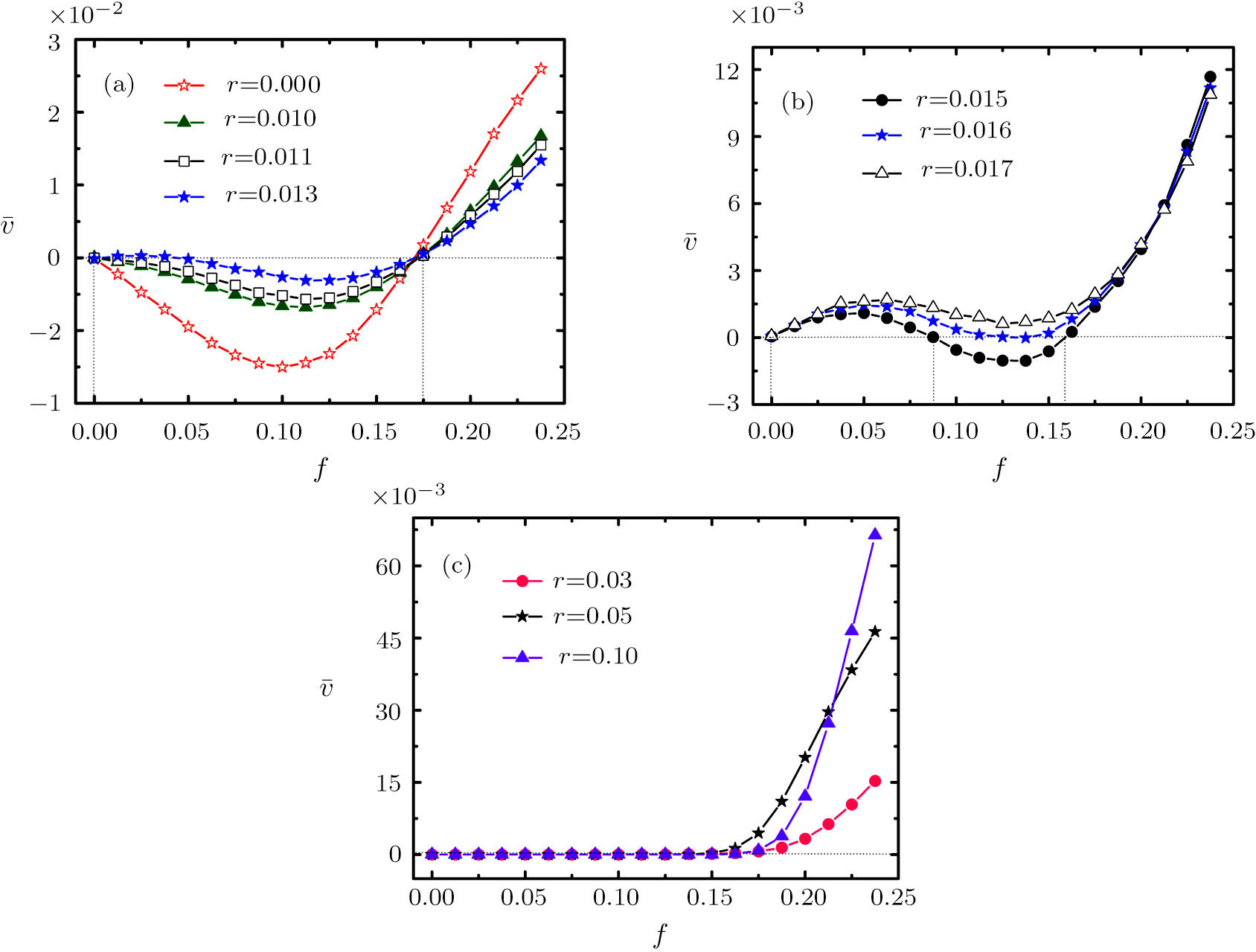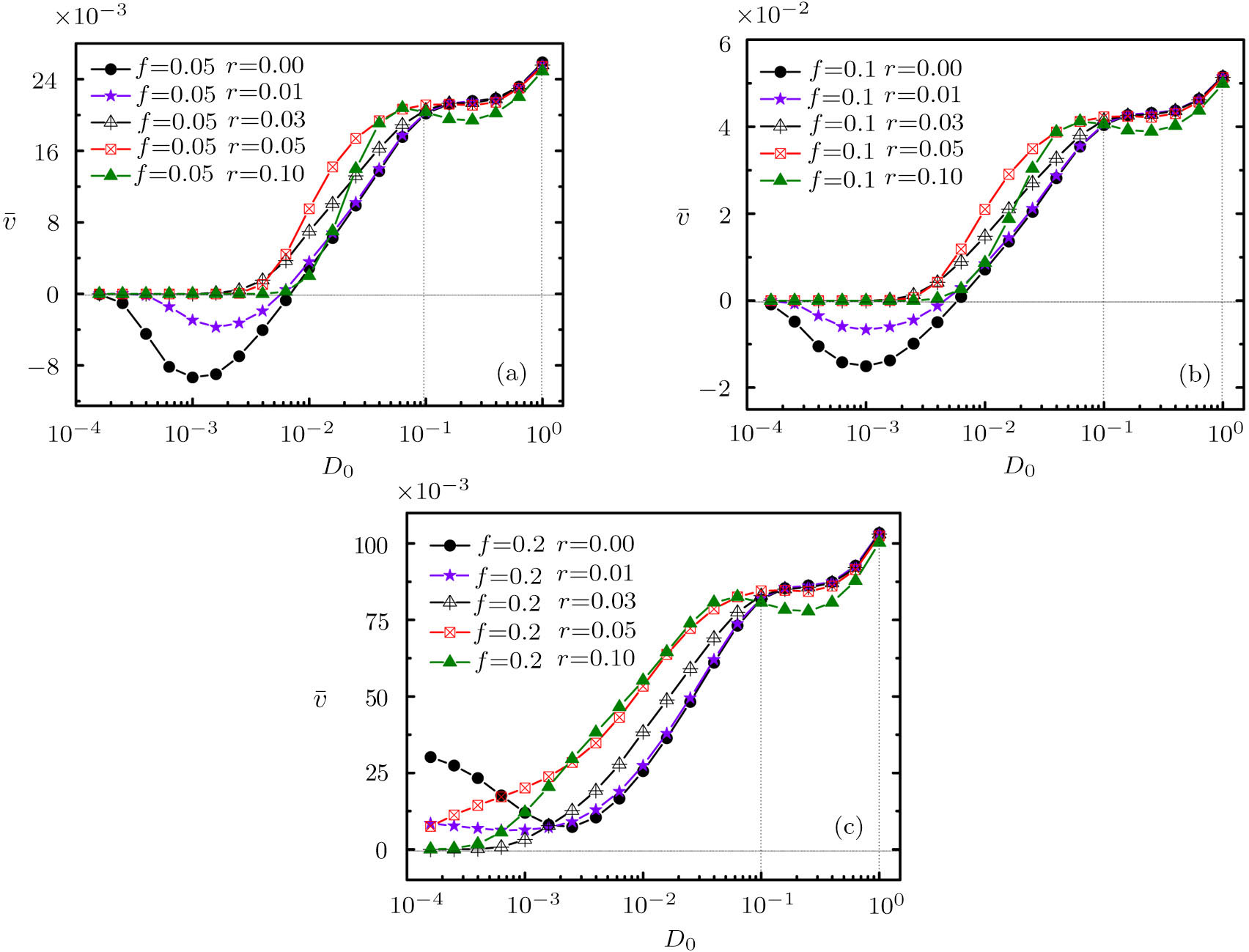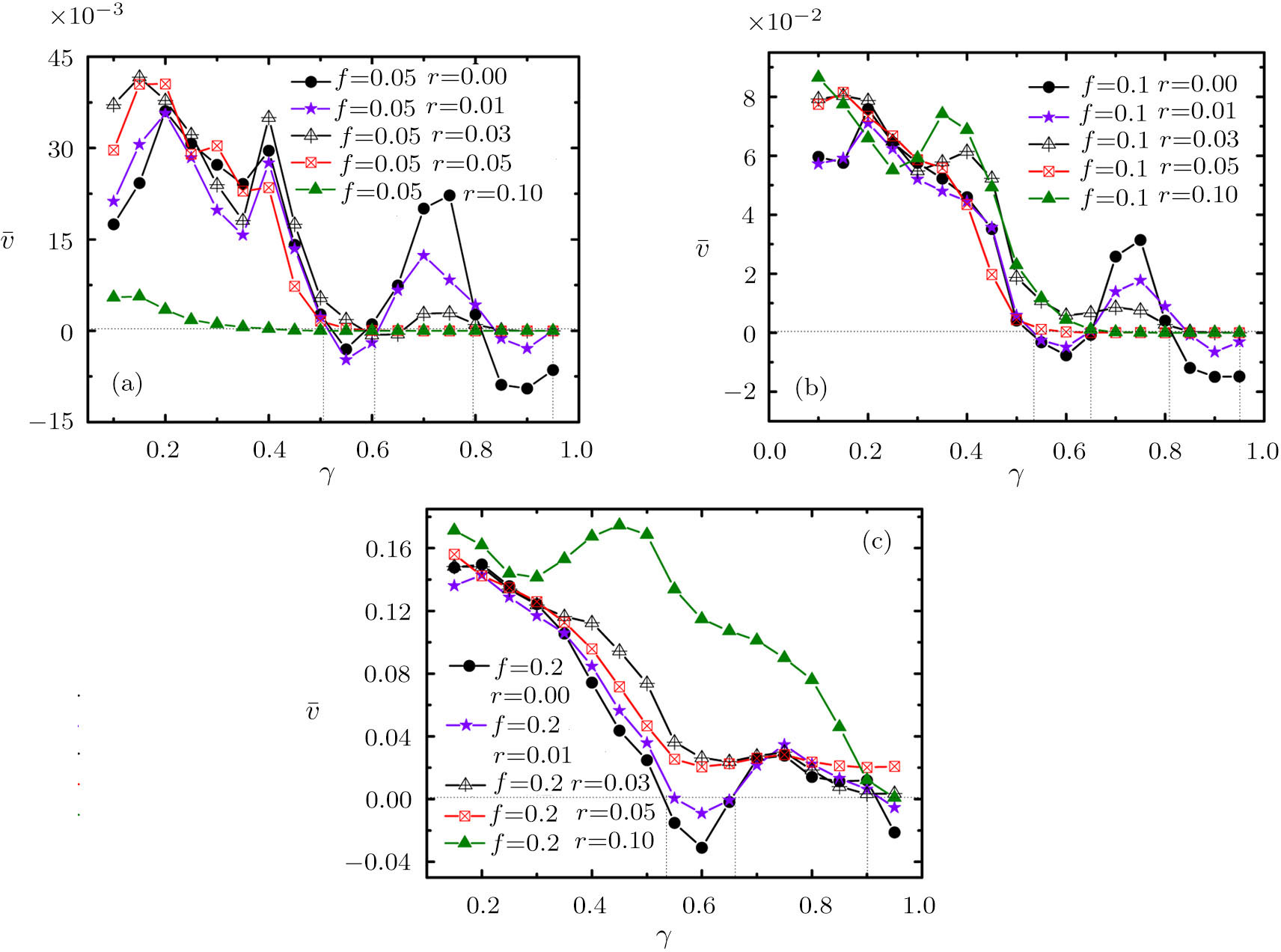† Corresponding author. E-mail:
Transport of an underdamped Brownian particle in a one-dimensional asymmetric deformable potential is investigated in the presence of both an ac force and a static force, respectively. From numerical simulations, we obtain the current average velocity. The current reversals and the absolute negative mobility are presented. The increasing of the deformation of the potential can cause the absolute negative mobility to be suppressed and even disappear. When the static force is small, the increase of the potential deformation suppresses the absolute negative mobility. When the force is large, the absolute negative mobility disappears. In particular, when the potential deformation is equal to 0.015, the two current reversals present with the increasing of the force. Remarkably, when the potential deformation is small, there are three current reversals with the increasing of the friction coefficient and the average velocity presents a oscillation behavior.
When a system at rest is perturbed by an external force, it usually responds by moving in the direction of that force. However, in many situations, the quite surprising contrary behavior in the form of a permanent motion against a (not too large) static force of whatever direction is known as absolute negative mobility. The absolute negative mobility is impossible in a heat-balanced system because it violates the second law of the thermodynamics. Therefore, the study of the absolute negative mobility in the ratchet has aroused much attention in theoretical and experimental physics.[1–7]
The phenomena of the absolute negative mobility are showed in many different cases. In a spatially symmetric and periodic system, which is far from thermal equilibrium, it is discovered that the average particle velocity of the single Brownian particle is positive for negative force and negative for positive force.[1] When several inertial Brownian particles move in a symmetric periodic potential under the influence of a time periodic and a constant, biasing driving force, thermal equilibrium fluctuations can cause the absolute negative mobility.[2] The overdamped motion of Brownian particles is analysed in the one-dimensional system with a symmetric serration potential subjected to both unbiased thermal noise and spatially inhomogeneous three-level colored noise. It is found that the appearance of the absolute negative mobility depends on the parameters of nonequilibrium and thermal noises such as amplitude, temperature, switching rate.[8] In addition, the absolute negative mobility can be induced by the spatial asymmetry in the shape of the transported particles,[4] white Poissonian noise,[6] the colored thermal fluctuations.[5]
The absolute negative mobility has been experimentally detected and theoretically studied in p-modulation-doped multiple quantum wells,[9] semiconductor superlattices,[10] and tunnel junction in superconductor devices.[11] In addition, negative conductances or even absolute negative conductances have been theoretically interpreted in the Josephson junctions[12–15] according to electric transportation.
However, in contrast to the regular potential, the shape of the substrate potential, which deviates from the standard one is more common in the real physical systems. The deformation of the potential may have a great influence on the transport characteristics of the particle. In the physical situations, application of standard Frenkel-Kontorova (FK) model could be very restricted, and real physical systems could not be “exactly” described by standard models.[16] For wider generality, Remoissenet and Peyrard[17–18] obtained in a control manner by an adequate choice of parameters rich variety of deformable potentials related to the physical systems such as Josephson junctions, charge-density wave condensates, and crystals with dislocations, these deformable potentials allow the modeling of many specific physical situations without employing perturbation methods. Therefore, it is necessary to study the influence of the deformation of the potential on average particle velocity. In this paper, we extend the previous work from standard sinusoidal potentials to the asymmetric deformable potentials. We will focus on how the deformation of the potential affects the directed transport. Since the inertial of the particle affects the anomalous transport feature, we will discuss the underdamped motion of a Brownian particle.
We consider underdamped dynamics of a Brownian particle in the presence of the one-dimensional asymmetric deformable potential.[17,19] The particle is subjected to both an unbiased time-periodic external force A cos(Ωt) and a constant force F. Its dynamic can be described by the following inertial Langevin equation:[2,20]

The asymmetric deformable potential can be given by[17,19]









Here we will use Brownian dynamic simulations to study the transport of the particle. The average velocity 

During the numerical simulations, we set the step time Δt to be 0.001 and the total integration time to be more than 107. Unless otherwise noted, our simulations are under the parameter sets: γ = 0.9, ω = 4.9, a = 4.2, ΔU = 1.0, and D0 = 0.001.
Figure 





 | Fig. 1 (Color online) Average velocity  |
When r is not equal to zero, the deformable potential has two inequivalent wells with the flat and sharp bottoms. When the particle stays in the flat well, it can easily pass through the barriers although the force acting on it is very small. When the particle stays in the sharp well, although the acting force is very large, it is also hard for the particle to pass through the barriers. Therefore, the flat well is beneficial to the particle’s transport while the sharp well impede the particle’s transport. When r increases but it is smaller, the effect of the flat well on particle’s transport is larger than that of the sharp one. At this time, the flat well dominates the particle’s transport and the absolute negative mobility is suppressed. On the further increasing r, the particle in the sharp well is trapped more strongly. When the force is not large enough, the particle can not pass through the potential, so the average velocity 

In Fig. 


 | Fig. 2 (Color online)Average velocity  |
It is well known that the system is in underdamped state when the friction coefficient γ is small. The system will move with the periodic oscillation and the amplitude of the oscillation logarithmically decreases with the time increasing. However, when γ is large enough, the system is in overdamped state and it will slowly move to the equilibrium position without any oscillation. In Fig. 




In summary, we numerically study the transport of a particle in a one-dimensional asymmetric deformable potential. It is found that the competition between the force and the deformation of the potential can result in the current reversals and the absolute negative mobility suppressed. Remarkably, when the deformable parameter r = 0.015, there are two current reversals presenting. When r ≤ 0.016, the absolute negative mobility is suppressed with the increasing of r. When r > 0.016, the absolute negative mobility disappears. When the noise intensity, the force, and the potential deformation are small, the absolute negative mobility and current reversals present, whereas the absolute negative mobility disappears when both the force and the potential deformation are large. Very interestingly, the average velocity behaviors as a function of the friction coefficient for different values of r and f are very different. These show the oscillation motion and three reversals with the increasing of γ, which means that there exists two intervals of the absolute negative mobility when r is small. Therefore, we can obtain the current reversals and control the particle’s transport direction by changing the potential deformation. The results we have presented may be another way to manipulate the transport of particles in complex environments. Furthermore, we expect our results can help people develop a new route to control particle systems based on the underdamped dynamics.
| [1] | |
| [2] | |
| [3] | |
| [4] | |
| [5] | |
| [6] | |
| [7] | |
| [8] | |
| [9] | |
| [10] | |
| [11] | |
| [12] | |
| [13] | |
| [14] | |
| [15] | |
| [16] | |
| [17] | |
| [18] | |
| [19] | |
| [20] |



